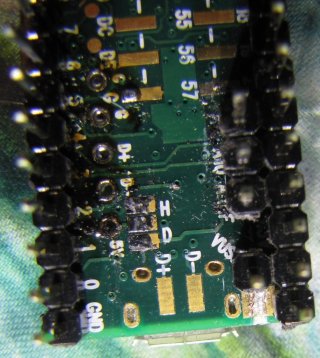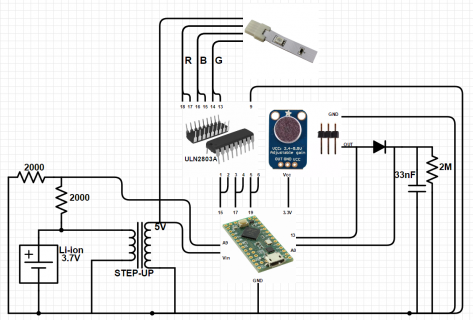Hello,
Seems my +3.3V line and my GND on my teensy 3.1 have shorted together and are permanently fused. I've ordered another one, but I’m concerned that just assuming "oops, must have just bumped an exposed wire against something bad.... it won't happen again" is just asking for it to happen again.
I'm assuming the possible ways this could have happened are numerous and impossible for someone to identify on a forum post, so instead I figured I'd just ask some general questions about what it would take for this to happen. Then, at least I can rule out possibilities that people are confident are impossible and investigate possibilities that people think might be likely.
I will say however that the board was powered by the USB in parallel with a BEC (battery elimination circuit, regulated 5V) from a brushless speed controller. I never cut the trace between VUSB and VIN because both inputs are a regulated 5 volts. Also, I'm aware of the short because my multimeter reads +0.02V between the +3.3v line and GND when the thing is powered (+4.3v between the VIN and GND) and when unpowered the continuity meter reads "0" (Closed). (I'll include a little more detail at the end in case ppl are interested.)
So, to the questions (but feel free weighting in on whatever you think would do this):
- Can I assume the short is due to damage to the 3.3V regulator? Is there a vulnerable diode in there that if fried would connect 3.3 to GND? The Teensy 3.1 schematic makes it look like the regulator is internal to the microcontroller and not an external component mounted to the board. If that’s the case, it makes testing the regulator difficult (impossible?).
-I should note that never was any smoke, burning, sparks, smells, etc observed so I’m assuming the damage was quick and to a semiconducting device (not heat fusing traces together). I don’t see any diodes on the Teensy 3.1 schematic that if it failed closed would connect the 3.3 with the GND (can a capacitor fail open?). Does anyone know of a component (internal to the uC or external) that if damaged would result in this issue.
- Can the teensy 3.1 +3.3V regulator be damaged by drawing too much current from it? The pin out makes it clear that it is limited to 100mA. I had assumed that if you exceed this amount the device would just act flaky, not damage itself and fuse lines together.
- Could a short to an I/O pin effect the entire 3.3v line? I've read that drawing too much power from (or shorting out) an I/O pin can destroy that pin but not render the entire board useless. Ruling out the I/O pins would greatly narrow the possibilities.
-Can I assume that if there was a short between my +5V line (Vin) and GND that the teensy won’t necessarily be damaged because the current would bypass the uC altogether.
- The highest voltage on the board is +5V, is this even enough if I connected the power backwards to damage anything? I thought I read somewhere that it would take at least 6.0V to start blowing diodes on the teensy.
Just a little more detail incase ppl are wondering....
- my 3.3volt I2C devices seem to work fine.
- My teensy sends out servo and speed controller signals (I'm using it as an autopilot) and I was having issues with the motors starting by themselves and eventually concluded that if they want signal voltages from 3v to 5v and I'm giving them +3.3v, a nosiey signal line might be the cause of the flakey self-starting (more like half starts really).... anyway to correct this I'm using a Sparkfun bi-directional Logic Level Converter (LLC) to convert the 3.3v signals to 5V before going to the servos/ESCs. I bring this up because there might have been a short between one of the high side (5v) signal lines (output) and the LLC's GND.
Anyhow, so to sum up: if you had a teensy and wanted the 3.3v and gnd lines fused but could only use 5.0v and 2 amps (from the BEC) how would you do it?
Thanks
Seems my +3.3V line and my GND on my teensy 3.1 have shorted together and are permanently fused. I've ordered another one, but I’m concerned that just assuming "oops, must have just bumped an exposed wire against something bad.... it won't happen again" is just asking for it to happen again.
I'm assuming the possible ways this could have happened are numerous and impossible for someone to identify on a forum post, so instead I figured I'd just ask some general questions about what it would take for this to happen. Then, at least I can rule out possibilities that people are confident are impossible and investigate possibilities that people think might be likely.
I will say however that the board was powered by the USB in parallel with a BEC (battery elimination circuit, regulated 5V) from a brushless speed controller. I never cut the trace between VUSB and VIN because both inputs are a regulated 5 volts. Also, I'm aware of the short because my multimeter reads +0.02V between the +3.3v line and GND when the thing is powered (+4.3v between the VIN and GND) and when unpowered the continuity meter reads "0" (Closed). (I'll include a little more detail at the end in case ppl are interested.)
So, to the questions (but feel free weighting in on whatever you think would do this):
- Can I assume the short is due to damage to the 3.3V regulator? Is there a vulnerable diode in there that if fried would connect 3.3 to GND? The Teensy 3.1 schematic makes it look like the regulator is internal to the microcontroller and not an external component mounted to the board. If that’s the case, it makes testing the regulator difficult (impossible?).
-I should note that never was any smoke, burning, sparks, smells, etc observed so I’m assuming the damage was quick and to a semiconducting device (not heat fusing traces together). I don’t see any diodes on the Teensy 3.1 schematic that if it failed closed would connect the 3.3 with the GND (can a capacitor fail open?). Does anyone know of a component (internal to the uC or external) that if damaged would result in this issue.
- Can the teensy 3.1 +3.3V regulator be damaged by drawing too much current from it? The pin out makes it clear that it is limited to 100mA. I had assumed that if you exceed this amount the device would just act flaky, not damage itself and fuse lines together.
- Could a short to an I/O pin effect the entire 3.3v line? I've read that drawing too much power from (or shorting out) an I/O pin can destroy that pin but not render the entire board useless. Ruling out the I/O pins would greatly narrow the possibilities.
-Can I assume that if there was a short between my +5V line (Vin) and GND that the teensy won’t necessarily be damaged because the current would bypass the uC altogether.
- The highest voltage on the board is +5V, is this even enough if I connected the power backwards to damage anything? I thought I read somewhere that it would take at least 6.0V to start blowing diodes on the teensy.
Just a little more detail incase ppl are wondering....
- my 3.3volt I2C devices seem to work fine.
- My teensy sends out servo and speed controller signals (I'm using it as an autopilot) and I was having issues with the motors starting by themselves and eventually concluded that if they want signal voltages from 3v to 5v and I'm giving them +3.3v, a nosiey signal line might be the cause of the flakey self-starting (more like half starts really).... anyway to correct this I'm using a Sparkfun bi-directional Logic Level Converter (LLC) to convert the 3.3v signals to 5V before going to the servos/ESCs. I bring this up because there might have been a short between one of the high side (5v) signal lines (output) and the LLC's GND.
Anyhow, so to sum up: if you had a teensy and wanted the 3.3v and gnd lines fused but could only use 5.0v and 2 amps (from the BEC) how would you do it?
Thanks



